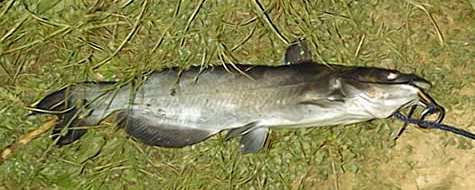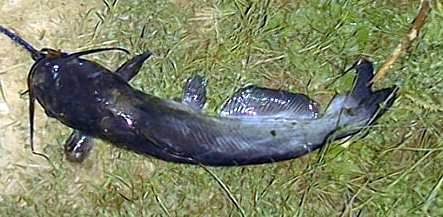Name/Relations || Range/Sizes || Habitat & Habits || Notes
 |
|
 |
Note: Count the rays (spines) on the anal fin- 24 to 29 for a channel cat |
Common Name:
Channel Catfish
Other Common Names:
Silver cat, river catfish, spotted catfish, Channel cat
Scientific name:
Ictalurus punctatus
Family:
Ictaluridae (North American Freshwater Catfishes)
Related Species:
Blue Catfish, White Catfish, Black Bullhead
| Range: Originally Mississippi River Basin and tributaries. Widely stocked throughout North America, and common in aquaculture. |
Sizes: Can reach over 60 pounds, but larger specimens are commonly confused with Blue Catfish. Most are stocked at 10" and caught from 12"-18", though fish up to 20lbs are not uncommon.
Habitat: Very versitile and can survive in nearly any freshwater or brackish water habitat in North America, as long as sufficient food and oxygen are present, and spawning habitat (see below) is available. Prefers water in the 65 degree F to 80 F degree range but can handle water from 35 F to 90 F. Commonly stocked in farm ponds, lakes, streams, swamps,and rivers, including the city parks of many very large cities such as New York, St. Louis, Chicago, Sacremento, etc. Chances are if you see a slow moving public waterway or lake in the US or Southern Canada it will probably have these fish in them.
Spawning Habits: Spawning begins in the spring when the water temperature hits 75 degrees F. The male and female seek out structure, preferably a hole in rocks or fallen logs, but can be excavated from debris or mud by the male, or a borrowed burrow from another animal. The male and female cat enter the spawning hole and spawn. The male catfish then guards the eggs alone until they hatch.
Feeding Habits: Channel catfish are very omnivorous, eating almost any animal or vegitable matter, alive or dead. They will actively seek out worms, crayfish, molluscs, dead birds, frogs,and minnows with their whiskers and lateral line, but scent (recieved via the whiskers) is definitely the number one tool for finding food. As these catfish grow past 10 pounds, however, they will concentrate on live or dead fishes, especially Cyprinids (i.e. chubs, shinners, suckers) and Gizzard Shad. They feed most actively at night and an hour after sunrise or two hours before sunset, but will occasionally feed all day and night, especially during and after heavy rains. In large lakes and slower rivers, the bulk of channel cat will concentrate around mud and sand flats, especially those with mussel beds, in 4 feet - 20 feet of water of river bends, especially where the flat drops off into deeper water or near rocks and fallen trees. In impoundments and large rivers, large channel catfish will sit in whirlpools behind dams and locks to intercept disoriented or cut up baitfish.
Notes:
The most commonly farmed fish in North America due to its swift growth,
tasty meat, and prolific nature. Commonly in supermarkets and on
resturant menus, and heavily stocked in any water that will hold them.
It is commonly stocked in farm ponds with Bluegill and Largemouth Bass,
where larger 8lb or better catfish become the top of the food chain and
keep the bluegill and small bass in check. Along with the bluegill,
it is one of the most common targets of bait anglers, and a fairly large
industry in prepared dough baits has emerged in the US. Will on occasion
take slowly fished lures intended for crappie or bass, and will also take
wooly worm flies when aggressively feeding. Most often fished using
tightline methods (egg weight rig, bait finder), many a channel cat has
succumed to baits fished 2feet-4feet under a float, or freelined.
My number one technique for larger channel catfish (4lbs-20lbs) is a freelined
live shad, at sunset, over a mud flat near a channel with deeper water.